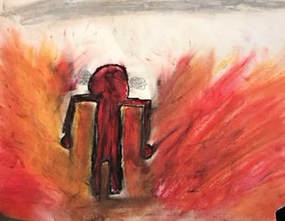Expressive Arts Modalities
The expressive arts in counseling helps us to connect, process, and understand experiences, memories, and emotions. The expressive arts includes:
- Art (paint, draw, sculpt)
- Dance or movement (yoga)
- Music
- Poetry/Journaling
- Drama
- Photography
- Guided Imagery
Creativity in CounselingWe connect with our environment though imagery, music, dance, poetry, etc. Expressing our inner world through the arts helps to access and process our inner worlds.
Art making has been used for thousands of years to help provide a meaningful connectedness with our being and our environment. From the discovery of ancient cave paintings to modern day graffiti, pictorial images and symbols have been used to help people interpret their world (Naumburg, 1966). |
It's Your Journey
If you haven't reviewed the Scribble Drawing activity, please do that before reading on. I like the idea that everything has a starting point - and the journey after that starting point is the goal. Too many times the focus is on the end goal and we forget about the experiences we have while we're trying to reach that goal. Forgetting about this process will only make the time spent while trying to reach your goal very stressful. So let’s explore how we can be more present, enjoy our journeys, and be creative!
Before I go into all the awesome benefits of creating I want to define for everyone what that actually is. We’re creating all the time, but we don’t realize it because maybe we didn’t produce a product or understand the intrinsic benefits of creating.
Before I go into all the awesome benefits of creating I want to define for everyone what that actually is. We’re creating all the time, but we don’t realize it because maybe we didn’t produce a product or understand the intrinsic benefits of creating.
Creativity
Creativity is the ability to approach an object or situation from an alternative perspective (i.e., music, dance, drama, poetry, image making, etc). Now add this definition to being a counselor. All counselors can be creative. But wait! What if you’re not an art therapist, expressive arts therapist, music therapist, drama therapist, etc? You are okay....adding creativity into your counseling practice cannot make an expressive arts therapist. That takes years of training, practice, and supervision. But you can be creative and add creativity into your counseling practice OR for your own well-being.
Getting Started
For years, my counseling students have asked me how to add creativity into their practice. This just simply isn’t taught in traditional counseling programs. As a trained art therapist and a licensed professional counselor I’ve never had to think about this question; I used creativity every day with my clients. I soon found out (through my supervision of new counselors) how often counselors add the creative arts into their practice. Sometimes done well....sometimes not so well. The following will provide a little guidance and background into getting started.
|
Here are some key take-aways about art-based interventions:
|
Benefits
|
Now that we have a good idea of what creativity is and some of the different modalities, let's discuss the creative process. The therapeutic process of creation is founded in the thought that artistic self-expression helps people. period. It can help people:
|
The expressive process helps people decrease:
|
Being Intentional
Sounds good huh? So how do we practice this? Being creative for ourselves is very different than adding creative interventions into our practice with others. The latter must be intentional....Why are we doing what we’re doing? What is the end goal? Why this intervention? Using creative interventions is a powerful tool with many benefits including:
- Helps capture and maintain interest and motivation in the counseling experience.
- Allows for an accepting, respectful, and safe environment
- Helps gain mastery through senses
- Allows the processing of the traumatic experience to be contained and not become overwhelming
- Inspires creative problem solving
- Promotes feeling identification
- Makes the unconscious conscious
- Supports emotional and behavioral self-regulation
- Promotes arousal reduction
- Appears less threatening or intimidating with special populations (Gladding, 2011).
Visual Arts: Materials
|
Before you go run out and start adding the creative arts into practice you must be aware of how materials can effect the process! Choice of material is important! Depending on who is doing the activity the material used should be well thought out. For example, I’m not giving my behaviorally out of control client paint! My goal would be to decrease the activity....thus, crayons or colored pencils just might be a better choice.
|





